

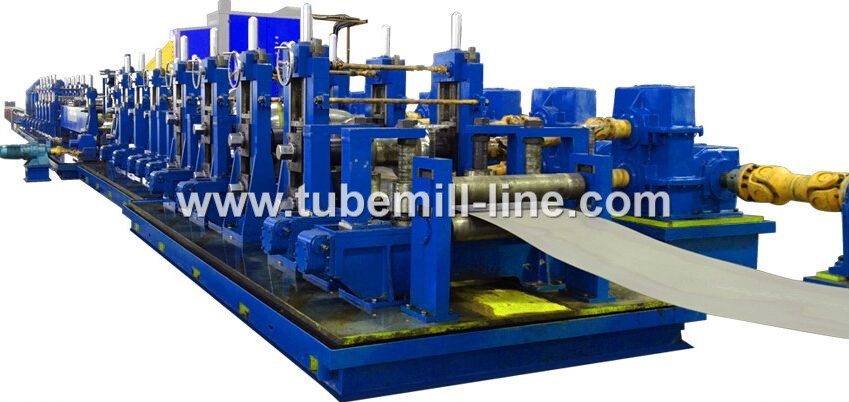
1. Decoiler/Uncoiler
Disassemble the hot/cold rolled steel coil and send it to the leveler. There are two ways of unwinding: upper and lower unwinding. In the tube mill line field, we always choose the upper unwinding.
Nomally, we have several types:
1.1, single side uncoiler, double side uncoiler
1.2, manual expansion, pneumatic expansion, hydraulic expansion
1.3, pneumatic brake/disc brake, hydraulic brake/disc brake
1.4, with coiler presser roller, the roller can be free roller, can be driven roller powered by dydraulic or by motor.
2. Shearing and butt welding machine
In order to ensure the continuous production of the production line, the irregular head and tail ends of the front and rear strips need to be cut neatly by a shear butt welding machine, clamped in the center, and welded together to form a continuous production strip.
Nomally, we have several types:
2.1, Full automatic shearing and butt welding machine
2.2, Half automatic clamp with shearing, but with manual welding
3. Material storage cage/accumulator
In order to meet the continuous production of welded pipes, a looper storage device must be installed to storage the steel strips to ensure continuous production of the unit.
There we have several types:
3.1, Vertical storage cage
3.2, Horizontal storage cage
3.3, Hozizontal accumulator
3.4, Vertical accumulator
4. Steel strip leveler (leveler)
Level the strip before forming. It is generally composed of an upper base, a lower base, a transmission device, etc. There are five rollers and seven rollers. In the welded pipe mill production line, there is usually a pinch roller in front of the leveler.
5. Forming machine
The tube mill forming machine will take a continuous strips to roll forming from breakdown roll stand/stations to fin-pass roll tooling stand/stations until the edges of the strip meet together to form a V welding angle.
The tube mill machine stands/stations are important.
The high precision machining job will be a good tube mill line quality guarantee.
The tube mill roller design is also important, which will influence the forming machine performance.
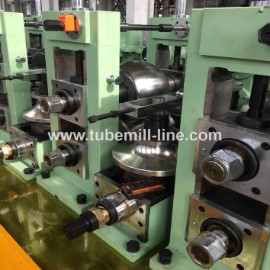
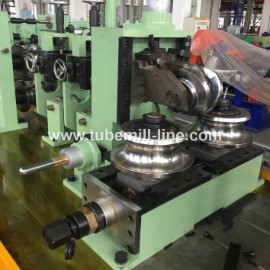
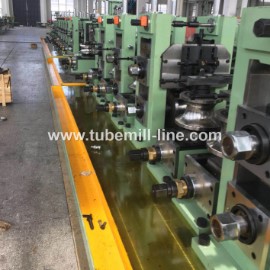
6. High frequency welding machine
Using the skin effect and proximity effect of high-frequency current, the metal of the weldment to be welded can be quickly heated to the molten state, and the welding is achieved by SQ roller extrusion. At this point the HF welding process melts and fuses the edges of the tube together and the material exits the weld station as the welded tube. The current frequency range of high frequency welding is usually 300-450KHZ, power is 100-1000KW. At present, the use of solid-state high-frequency welding machines is advocated. Now, we have the compact HF Welder, it will saving the energe and installation space.
7. Deburr, welding bead remove device
In the welded tube/pipe mill process, it is used to remove the weld burr in the welded seam position.
8. Sizing machine / TH head straighter stations
The sizing unit usually consists of several driven horizontal stands/stations, passive vertical roller stands/stations and TH head straighter devices, which ultimately ensure the accuracy of the outer diameter and cross-sectional shape of the steel tubes, and also can improve the stress concentration and residual stress of the forming and welding production.
The tube mill sizing machine stands/stations are important.
The high precision machining job will be a good tube mill line quality guarantee.
The tube mill roll tooling design is also important, which will influence the forming machine performance.
9. Extra higher requirements for the welding seam treatment for some special applications
9.1, welding seam annealing (heat) treatment
In the ERW/HF welded pipe process, normalizing the weld including the heat affected zone, or performing quenching + tempering and normalizing + tempering treatment on the weld. The metallographic structure and mechanical properties of the weld are consistent with the metallographic structure and mechanical properties of the base material, so as to eliminate welding stress and improve weld performance. The most widely used is the intermediate frequency heat treatment machine.
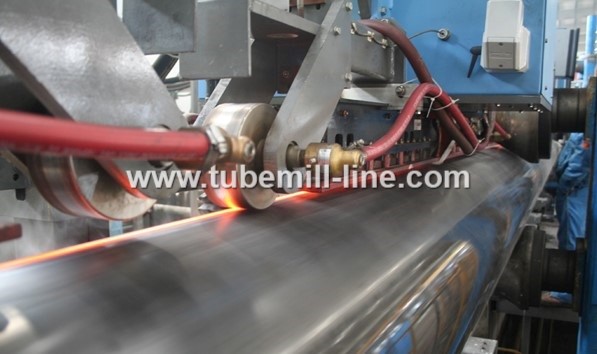
9.2, Welding seam quality test, Ultrasonic testing
Non-destructive testing method for detecting internal defects of materials by using the principle that ultrasonic waves will diffract when encountering interfaces of different density media during propagation.
9.3, Welding seam quality test, Eddy current testing
Mostly used for on-line inspection of small diameter ERW welded pipe. Because the probe does not contact the surface of the pipe, high-speed flaw detection can be achieved. The detection of defects on the surface of the pipe is more sensitive, and the detection of defects on the layer and inner surface is not ideal. It can detect tube and weld defects, and can use impedance plane technology to analyze the location and depth of defects.
10. Tube Mill Roller / Roll Tooling
The roll is the main tooling mold for the production of high-frequency welded pipes, and is the main consumable part. The types of rolls are divided into casting rolls and forging rolls according to the manufacturing method. We nomally, adopt the fogged raw material to do rough machining, heat treatment to reach HRC 58~62, finish machining with ceramic inserts. They are divided into integral rolls and combined rolls according to the process method. Some combined roller, the middle part is made from Tungsten steel raw material, it is very hard and expensive, but ensure you a much longer using life to save your cost. The roller quality directly affects output and cost of the product. A good tube mill roll set should include below aspects:
① According to the deformation modulus of the different raw material, perfect flower design to ensure the forming quality;
② The roll material must have high precision, high hardness, high wear resistance and toughness, to ensure that it has a long life;

11. Cutting machine
Important equipment for the continuous production line of fixed-length cutting machines for pipes and profiles. Realize high-precision fixed-length cutting under the online running state of pipes and profiles. The cutting forms include sawing, rotary cutting and punching, and the driving system includes DC servo drive system and AC servo drive system, which are controlled by a microcomputer to cut to length.
Nomally, we have several types: https://www.tubemill-line.com/Products/Tube-Mill-Cold-Cutting
11.1, Tube mill hot friction saw
11.2, Tube mill cold cutting saw
12. Automatic pipe stacking and packing into bundles
When the finished welded pipe with fixed length from cutting machien stations, we will make a run-out table to receive the pipes and packing them into bundles with labor jobs. Now, we have the machine for automatic steel pipe stacking and packing into bundles. Just operation the touch screen and type the requirements for what you need. It will save labor jobs and costs to make the round pipe into hex bundles, to make the square tubes into square bundles, and to make the rectangle pipes into rectangle bundles.
Nomally, we have several types:
12.1, The magnetic lift type for hex bundle, square, rectangle, and other
12.2, The forklift type for hex bundle, square, rectangle, and other
12.3, The simple-forklift type, with cheap cost, popular used, specially used for square, rectangle, and hex bundle.
13. Chamfering machine
The ends of the pipe cut by the hot/friction saw cutting machine generally have some cut defects and burrs. In order to meet the requirements of the subsequent process and the user's bevel, the burrs and the inner and outer edges of the pipe end need to be chamfering and trimmed. Flat-head chamfering machine is a device for milling both ends of welded pipe. It is composed of steel pipe feeding device, steel pipe clamping device, knife holder, transmission device, frame body and other parts. The working process of the flat head chamfering machine can realize automatic continuous and automatic control.
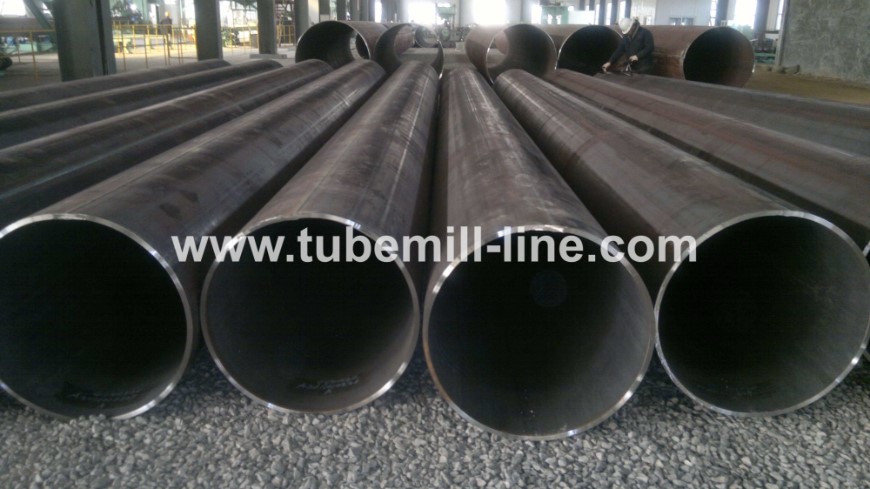
14. Hydrostatic testing machine
The hydrostatic test is the main equipment for the production of welded pipes. At present, the working process of the hydraulic testing machine used in the production of welded pipes is: feeding, clamping, water filling, pressurizing, holding pressure, releasing pressure, and discharging. The process also constitutes the basic action cycle of the test tube hydraulic press. Modern hydraulic test machines are controlled by PLC, so that each working process is automatically completed in sequence, and have the function of automatically recording test result parameters. According to the seal form, it can be divided into radial seal and end seal. Radial seal is a sealing ring matched with the inner diameter or outer diameter of the welded pipe. The expansion of the sealing ring under pressure to achieve the purpose of sealing the wall of the pipe. Its advantages are that the steel pipe is easily clamped and extracted, the seal is reliable, and the steel pipe is axially affected. The force is small and it is not easy to bend, but the structure of the sealing head is more complicated, there are more specifications, and there is a test blind area at the end of the pipe; the end face seal relies on the sealing material and the end face of the nozzle to press to achieve the purpose of sealing the nozzle, the advantage is that the test structure is simple , Good versatility, but higher requirements for sealing material performance and oil-water pressure difference ratio and servo control system.